Qualitative and Quantitative Investigations on the Failure Effect of Critical Fissures in Rock Specimens under Plane Strain Compression
Abstract
1. Introduction
- a.
- A series of rock samples with a particular fissure were individually designed, and 12 PSC tests were conducted for two kinds of lithology based on the DEM.
- b.
- The fracture mode, crack development, and evolution laws of various rock samples with particular fissures were qualitatively evaluated.
- c.
- Quantitative analysis was performed to explore the characteristics of the monitoring data of various specimens with certain fissures, and the following relevant quantitative indicators were proposed: the rock-bearing capacity index (RockBCI) and the time ratio index (TRI).
2. Materials and Methods
2.1. Methods
2.2. Rock Model
2.3. Test Design
- (a)
- Fracture Modes: The differences and causes of the fracture mode and crack development in two kinds of rock samples with various types of fissures under PSC.
- (b)
- Date Characteristics: The relationship between the bearing capacity, expansion of the free direction, and crack number of rock samples under PSC, as well as the impact of the different types of fissures on the bearing capacity after the peak stress of the rock.
- (c)
- Crack Evolution: The effect of various types of fissures on the process of the rock specimens from local damage to complete fracture under PSC.
3. Results
3.1. Fracture Modes
- (a)
- It was found that 90° fissures had the smallest effect on the original fracture mode. For instance, the granite sample with a type 3 fissure had almost the same fracture mode as the type 0 sample. Moreover, the shear fracture angle of the granite with a type 1 fissure had the same fracture mode as the type 0 sample, but the fracture surface did not occur along the fissure face.
- (b)
- It was found that 45° fissures changed the original fracture angle and directly caused the weak face to fracture under shear. The fracture surface of the granite samples was along the 45° fissure, while the fracture surface of the sandstone samples did not form entirely along the 45° fissures but at an angle below 45°.
- (c)
- It was found that 0° fissures were also the dominant factor of weak surface shear damage. Cracks were developed from the 0° disk end to the sample end to generate the shear fracture surface.
3.2. Data Characteristics
- Damage starting point (DSP): At this point, the axial and confine wall stress were still in a linear growth stage.
- Initial critical expansion point (CEP0): At this point, the axial stress entered the deceleration growth stage with the lateral strain, which was the starting point of the bearing platform at the peak stage, indicating the beginning of the nonlinear deformation stage of the rock samples. At the same time, the confined wall’s stress began to rapidly increase, and the microcrack development also started to significantly rise.
- First critical expansion point (CEP1): At this point, the axial stress began to quickly drop, which was the end of the bearing platform. Simultaneously, the microcrack growth rate reached the maximum.
- Second critical expansion point (CEP2): At this point, the decrease in axial stress at the post-peak stage significantly slowed down. At the same time, the stress of the confine wall reached its maximum value, and the microcrack development began to significantly decelerate.
- a.
- Peak stress comparison:Figure 8c shows that type 5 and 4 fissures most significantly weakened the axial peak stress. The type 5 horizontal fissure caused an intense stress concentration because the fissure surface was perpendicular to the axial loading direction. Although the “beam” effect of the type 4 fissure was small, it caused the fracture surface of the sample to occur along the fissure surface, thus reducing the bearing capacity of the rock sample.
- b.
- Distribution of characteristic points: The aggregation of four characteristic points was more evident in the granite samples, indicating that the stage process of the damage and collapse of the granite samples was more prominent. The short interval between the CEP0 cluster and the CEP1 cluster of sandstone indicated that the process of the bearing platform of sandstone was short. The sequence of each characteristic point varied between rock samples with various fissures. For rock samples with type 3 and type 1 vertical fissures, their DSP was the most forward and their CEP2 was the most backward. For rock samples with type 5 and type 10 horizontal fissures, their CEP1 was the most forward but their CEP2 was relatively lagging.
- c.
- Quantitative index analysis: The sequence of the RockBCI1 was 3 > 2 > 4 > 1 > 5 (fissure type) for the granite samples and 3 > 2 > 1 > 4 > 5 for the sandstone. The sequence of the RockBCI2 was 3 > 2 > 5 > 4 > 1 for the granite samples and 1 > 5 > 2 > 3 > 4 for the sandstone. The bearing capacity of the granite samples at the peak and post-peak stages was identical. Three types of fissures most weakened the bearing capacity of the specimen: horizontal fissures, fissures whose angles coincided with the fracture surface, and fissures whose surface was perpendicular to the confine wall direction. In the peak stage, the bearing capacity of the sample with horizontal fissures was the worst, and in the fracture stage, the bearing capacity of the sample with 45° and 90° fissures was the lowest. The sequence of the RockBCI of CEP1 in the sandstone samples with fissures was identical to that of granite, whereas the sequence of the RockBCI of CEP2 in the sandstone samples was different from that of granite. CEP2 hysteresis was observed in the granite sample with the type 3 fissure.
- d.
- Analysis of CEP hysteresis: The granite sample with a type 3 fissure was unique because its RockBCI of CEP2 was greater than that of the rock sample without any fissures, as shown in Figure 8d for the column that exceeds the red line. Figure 9 shows a simplified diagram of the stress of the confine wall and the damage trend under the situation, indicating that there are two reasons for the CEP hysteresis. First, the type 3 fissure had almost no effect on the fracture mode of the rock sample; second, the presence of the fissure reduced the stress of the confine wall and axial stress relative to a rock sample without any fissures, allowing for local damage within the sample to further develop and delay the fracture.
3.3. Crack Evolution
4. Conclusions
- (1)
- Rock samples containing a particular fissure under PSC generally showed a weak face shear fracture mode, and the fracture mode was affected by the lithology, fissure angle, and fissure direction. Lithology was found to mainly affect the fracture angle. The fissure angle affected whether a rock sample was fractured along the fissure face. The fissure direction and its stress state determined whether stress concentration occurred around the fissure, which significantly impacted the bearing capacity of the rock sample.
- (2)
- The CEPs of rock samples subjected to PSC were determined by analyzing elements of axial stress, confine wall stress, crack D&E trends, and the expansion of free surface (lateral strain). The damage start point, initial CEP, and first/second CEPs were the four CEPs. The two post-peak CEPs revealed the phase change of the damage and collapse of rocks under PSC. The RockBCI was proposed to represent the hysteresis of post-peak CEPs.
- (3)
- The CEPs and RockBCI can provide a technical foundation for quantitative analysis of the failure effect of fissures on rock samples. In this quantitative analysis, all test samples’ peak stress and RockBCI values had a uniform law. The bearing capacity of the rock samples with horizontal fissures, fissures whose angles coincided with the fracture surface, and fissures whose surface was perpendicular to the lateral confine direction were the worst. Their BCI2 values were found to be 80.6%, 70.8%, and 56.9% of the rock samples without any fissures, respectively. There was a type of fissure that delayed the fracture. One reason was that the fissure did not affect the fracture mode; the second reason was that the fissure reduced the stress effect in the loading and confine direction.
- (4)
- CEPs were used to divide the stages of the D&E of cracks, and the TRI was proposed to describe the time ratio between the CEP0–CEP1 and CEP1–CEP2 for rock samples under PSC. Cracks were found to develop from sporadic to local aggregation, gradually forming crack clusters. The crack clusters caused local damage to the rocks, but the specimens did not lose their bearing capacity until the local crack clusters continued to deepen and connect; then, macrocracks formed. The presence of internal fissures not only changed the path of crack deepening and connection but also modified the time course of rock damage and collapse.
- (5)
- A limitation of this study is that there were no further physical experiments. As mentioned above, PSC tests of rock materials are difficult to implement. The key to a successful PSC test is to define the accuracy control conditions of the confining device. In fact, we allowed our confining device to have a deformation, but the plane strain state of the rock samples had to be guaranteed. In a follow-up study, we will propose accuracy control conditions of a confining device for rock specimens and reproduce the test discussed in this paper through physical experiments.
Author Contributions
Funding
Institutional Review Board Statement
Informed Consent Statement
Data Availability Statement
Conflicts of Interest
References
- Bazant, Z.P.; Chen, E.P. Scaling of structural failure. Appl. Mech. Rev. 1997, 50, 593–627. [Google Scholar] [CrossRef]
- Zhao, Y. Retrospection on the development of rock mass mechanics and the summary of some unsolved centennial problems. Chin. J. Rock Mech. Eng. 2021, 40, 1297–1336. [Google Scholar]
- Munoz, H.; Kiyota, T. Deformation and localisation behaviours of reinforced gravelly backfill using shaking table tests. J. Rock Mech. Geotech. Eng. 2020, 12, 106–115. [Google Scholar] [CrossRef]
- Ho, L.; Fatahi, B. Analytical solution for the two-dimensional plane strain consolidation of an unsaturated soil stratum subjected to time-dependent loading. Comput. Geotech. 2015, 67, 1–16. [Google Scholar] [CrossRef]
- Potts, D.M.; Gens, A. The effect of the plastic potential in boundary value problems involving plane strain deformation. Int. J. Numer. Anal. Methods Geomech. 1984, 8, 259–286. [Google Scholar] [CrossRef]
- Liu, C.; Wang, Z.; Xiong, W.; Zhong, H.; Yuan, S. Effect of vertical strain and in-plane biaxial strain on type-II MoSi2N4/Cs3Bi2I9 van der Waals heterostructure. J. Appl. Phys. 2022, 131, 163102. [Google Scholar] [CrossRef]
- Wen, D.; Kong, B.; Wang, S.; Zong, Y. Effect of hydrogen on the flow behavior of a TiAl based alloy during plane strain compression at elevated temperature. Int. J. Hydrog. Energy 2019, 45, 4897–4909. [Google Scholar]
- Xu, L.; Xiang, M.; Wang, J.; Zhang, J.; Wang, C.; Xie, C. materials Analysis and Characterization on Dynamic Recrystallization in Casting AZ31 Mg Alloys Under Plane Strain Compression. Materials 2020, 13, 522. [Google Scholar] [CrossRef] [PubMed]
- Chen, C.; Qian, X. Quantifying through-thickness J for plane strain specimens using digital image correlation considering constraint effects. Eng. Fract. Mech. 2022, 267, 108430. [Google Scholar] [CrossRef]
- Tian, Z.; Tang, C.; Liu, Y.; Tang, Y. Zonal disintegration test of deep tunnel under plane strain conditions. Int. J. Coal Sci. Technol. 2020, 7, 337–349. [Google Scholar] [CrossRef]
- Wang, X.B. Entire deformational characteristics and strain localization of jointed rock specimen in plane strain compression. J. Cent. South Univ. 2006, 13, 300–306. [Google Scholar] [CrossRef]
- Labuz, J.F.; Dai, S.-T.; Papamichos, E. Plane-strain compression of rock-like materials. Int. J. Rock Mech. Mining Sci. Geomech. Abstr. 1996, 33, 573–584. [Google Scholar] [CrossRef]
- Yin, G.; Huang, G.; Li, D.; Wang, W.; Zhang, D.; Wei, Z. Rock Plane Strain Gauge. Chongqing CN 100557377C, 4 November 2009. [Google Scholar]
- Lei, T. A Fully Cast Plane Strain Test Bench. Jiangsu CN 2909226, 6 June 2007. [Google Scholar]
- Cho, N.; Martin, C.D.; Sego, D.C. A clumped particle model for rock. Int. J. Rock Mech. Min. Sci. 2007, 44, 997–1010. [Google Scholar] [CrossRef]
- Mahabadi, O.K.; Cottrell, B.E.; Grasselli, G. An Example of Realistic Modelling of Rock Dynamics Problems: FEM/DEM Simulation of Dynamic Brazilian Test on Barre Granite. Rock Mech. Rock Eng. 2010, 43, 707–716. [Google Scholar] [CrossRef]
- Yu, B.; Zhang, K.; Niu, G. Rock Strength Determination Based on Rock Drillability Index and Drilling Specific Energy: Numerical Simulation Using Discrete Element Method. IEEE Access 2021, 9, 43923–43937. [Google Scholar] [CrossRef]
- You, W.; Dai, F.; Liu, Y. Experimental and numerical investigation on the mechanical responses and cracking mechanism of 3D confined single-flawed rocks under dynamic loading. J. Rock Mech. Geotech. Eng. 2022, 14, 477–493. [Google Scholar] [CrossRef]
- Lee, H.; Jeon, S. An experimental and numerical study of fracture coalescence in pre-cracked specimens under uniaxial compression. Int. J. Solids Struct. 2011, 48, 979–999. [Google Scholar] [CrossRef]
- Huang, Y.H.; Yang, S.Q.; Tian, W.L. Crack coalescence behavior of sandstone specimen containing two preexisting flaws under different confining pressures. Theor. Appl. Fract. Mech. 2019, 99, 118–130. [Google Scholar] [CrossRef]
- Zhang, L.; Wang, G.; Lei, R.; Wen, X.; Liu, B.; Sun, F. Study on the energy damage evolution mechanism of single jointed rock mass with different length under uniaxial compression. China J. Highw. Transp. 2021, 34, 24–34. [Google Scholar]
- Park, C.H.; Bobet, A. Crack coalescence in specimens with open and closed flaws: A comparison. Int. J. Rock Mech. Min. Sci. 2009, 46, 819–829. [Google Scholar] [CrossRef]
- Miao, S.; Pan, P.-Z.; Wu, Z.; Li, S.; Zhao, S. Fracture analysis of sandstone with a single filled flaw under uniaxial compression. Eng. Fract. Mech. 2018, 204, 319–343. [Google Scholar] [CrossRef]
- Jia, P.; Yang, T.H.; Yu, Q.L. Mechanism of parallel fractures around deep underground excavations. Theor. Appl. Fract. Mech. 2012, 61, 57–65. [Google Scholar] [CrossRef]
- Zhao, Y.; Liu, J.; Jin, A.; Sun, H.; Wang, B.; Wei, Y. Study on failure characteristics of intermittent jointed rock mass under loading and unloading condition. J. Cent. South Univ. (Sci. Technol.) 2020, 51, 1893–1901. [Google Scholar]
- Cai, M.; Kaiser, P.; Morioka, H.; Minami, M.; Maejima, T.; Tasaka, Y.; Kurose, H. FLAC/PFC coupled numerical simulation of AE in large-scale underground excavations. Int. J. Rock Mech. Min. Sci. 2007, 44, 550–564. [Google Scholar] [CrossRef]
- Yoon, J. Application of experimental design and optimization to PFC model calibration in uniaxial compression simulation. Int. J. Rock Mech. Min. Sci. 2007, 44, 871–889. [Google Scholar] [CrossRef]
- Qiu, J.; Luo, L.; Li, X.; Li, D.; Chen, Y.; Luo, Y. Numerical investigation on the tensile fracturing behavior of rock-shotcrete interface based on discrete element method. Int. J. Min. Sci. Technol. 2020, 30, 9. [Google Scholar] [CrossRef]
- Castro-Filgueira, U.; Alejano, L.R.; Ivars, D.M. Particle flow code simulation of intact and fissured granitic rock samples. J. Rock Mech. Geotech. Eng. 2020, 12, 960–974. [Google Scholar] [CrossRef]
- Wang, T.; Han, Y.; Zhu, Y.; Zhang, F. PFC2D/3D Particle Discrete Element Method and Application; China Construction Industry Press: Beijing, China, 2020. [Google Scholar]
- Mohammadnejad, M.; Dehkhoda, S.; Fukuda, D.; Liu, H.; Chan, A. GPGPU-parallelised hybrid finite-discrete element modelling of rock chipping and fragmentation process in mechanical cutting. J. Rock Mech. Geotech. Eng. 2020, 12, 16. [Google Scholar] [CrossRef]
- Jing, H.; Yin, Q.; Yang, S.; Chen, W. Micro-Mesoscopic Creep Damage Evolution and Failure Mechanism of Sandy Mudstone. Int. J. Geomech. 2021, 21, 04021010. [Google Scholar] [CrossRef]
- Cui, J.; Liang, Q. Study on correlation between macro and micro mechanical parameters of rock based on PFC~(3D) model. Sci. Technol. Bull. 2019, 35, 8–15. [Google Scholar]
- Xu, Q. Research about Post-Peak Deformation Features and Brittleness Index of Granite; Northeastern University: Shenyang, China, 2014. [Google Scholar]
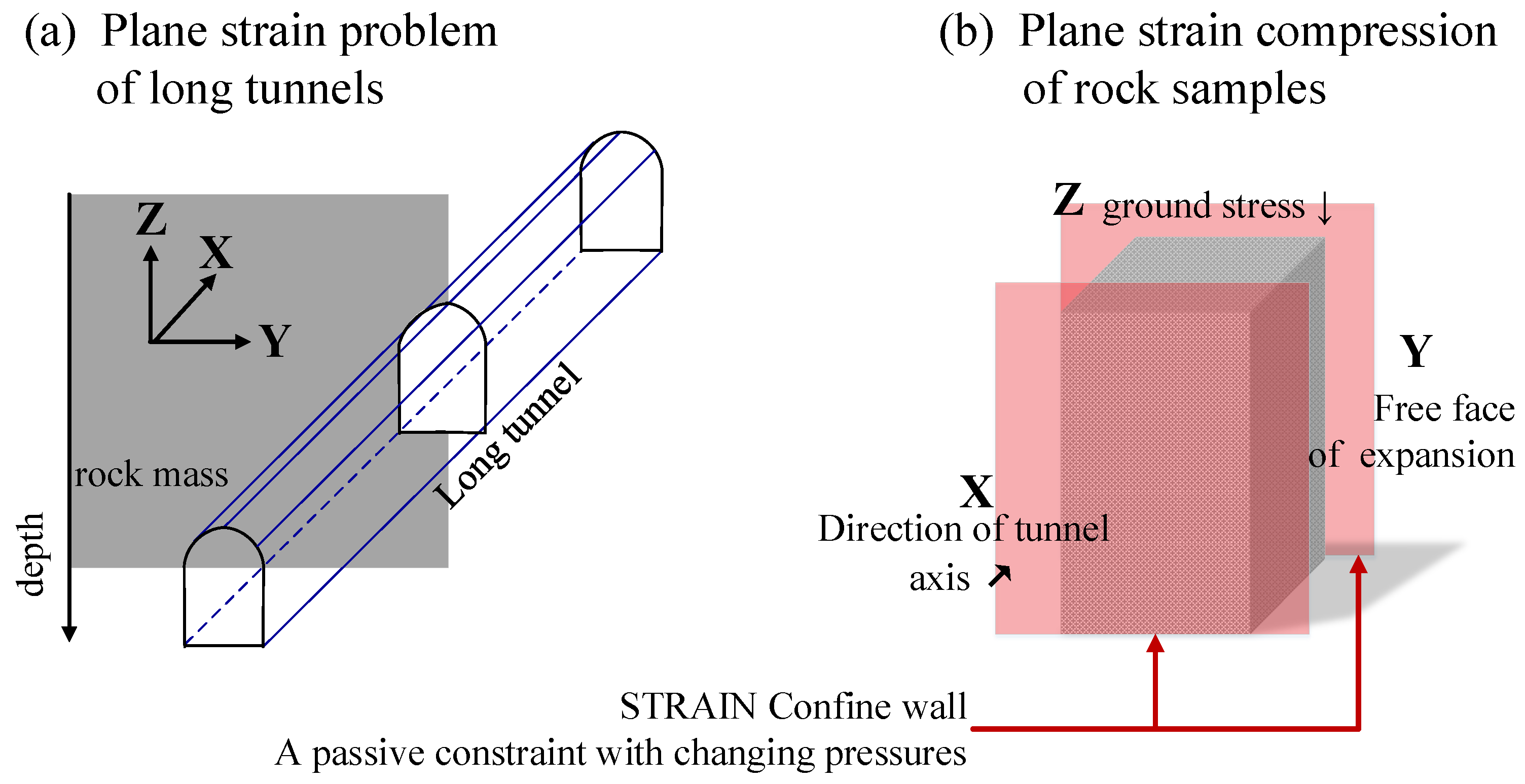
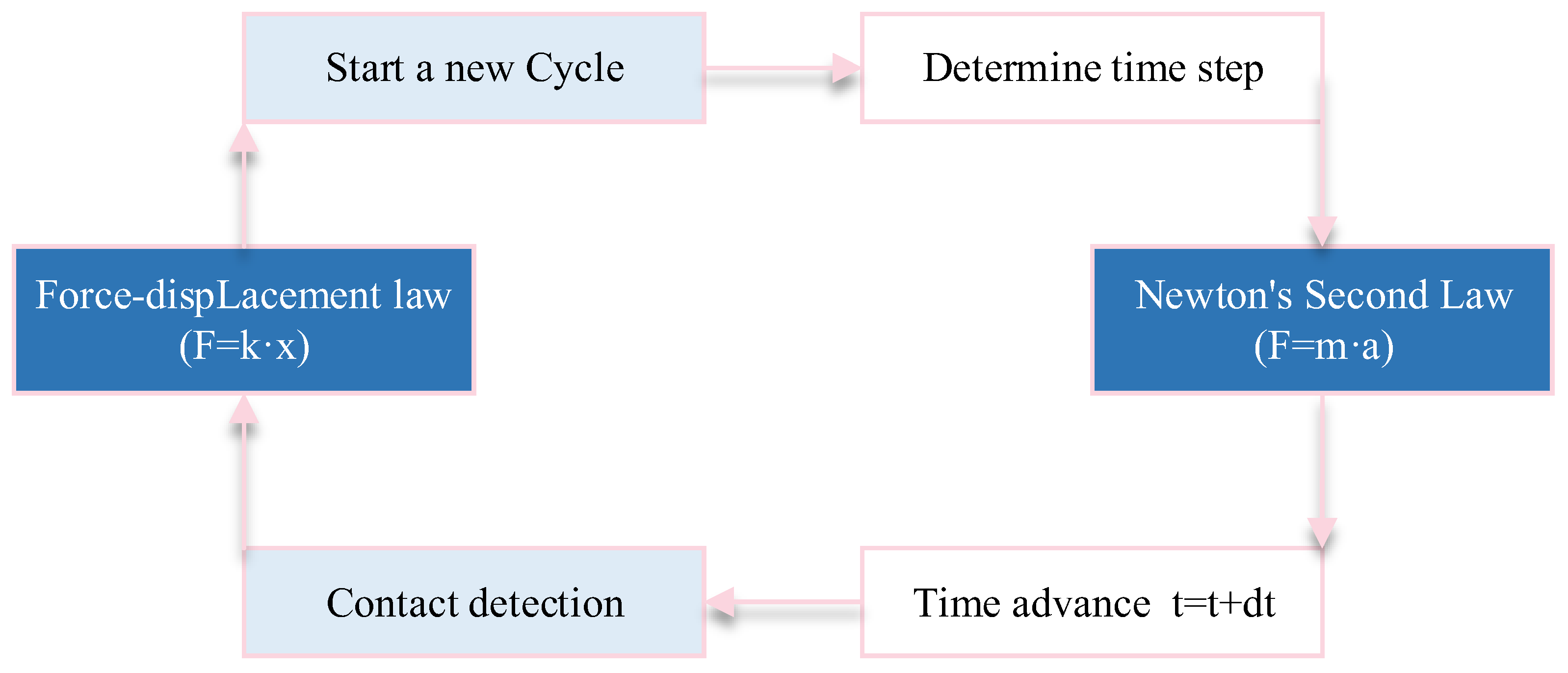

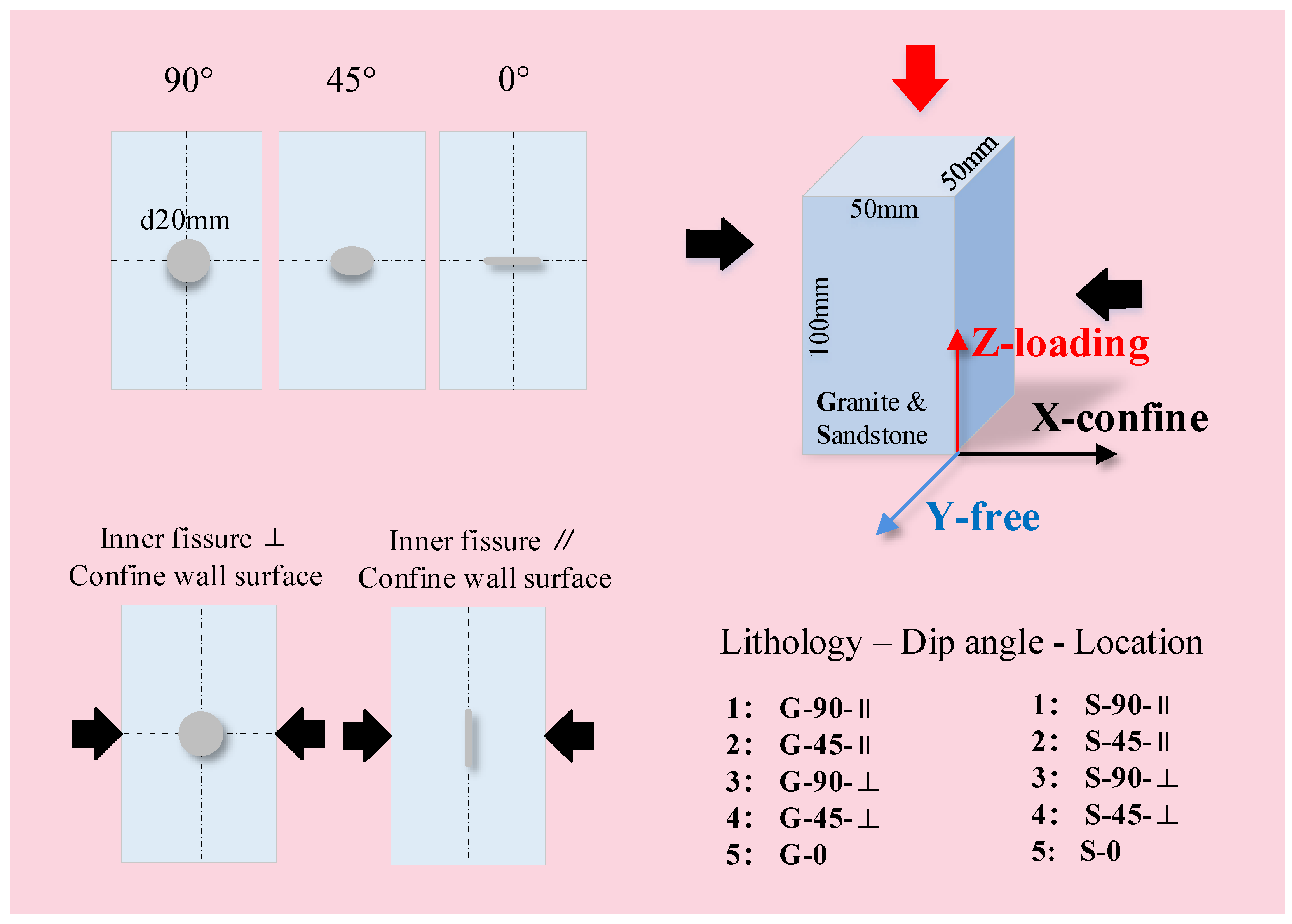
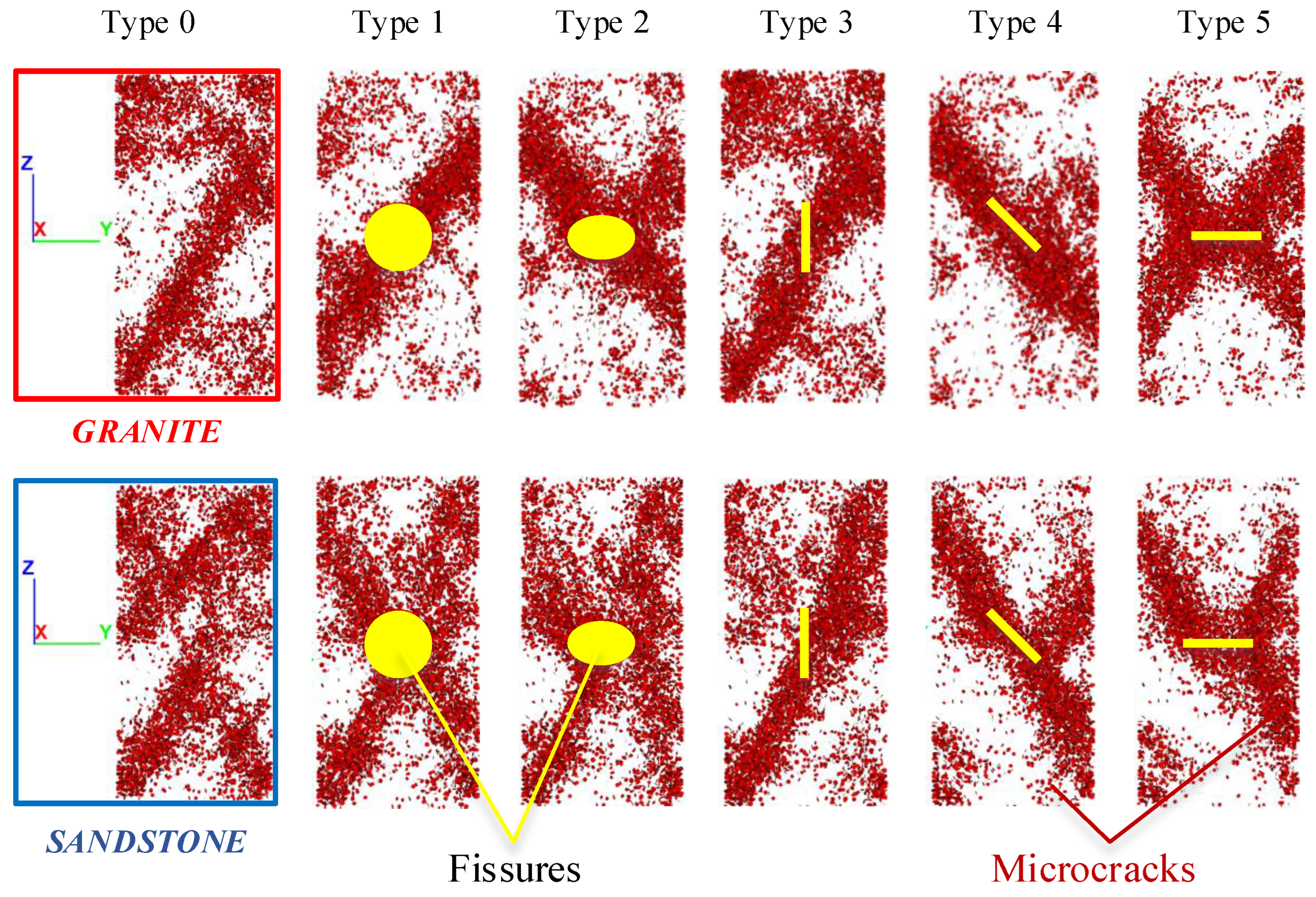
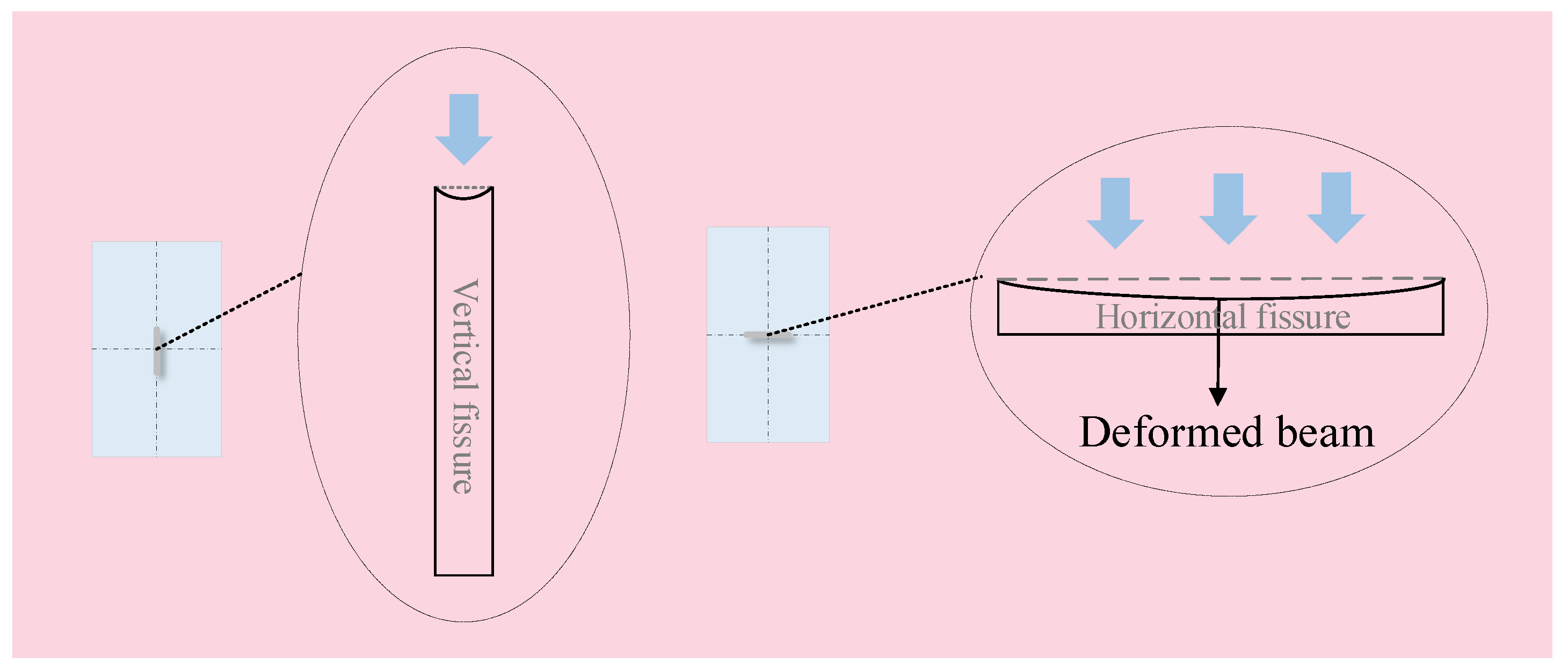

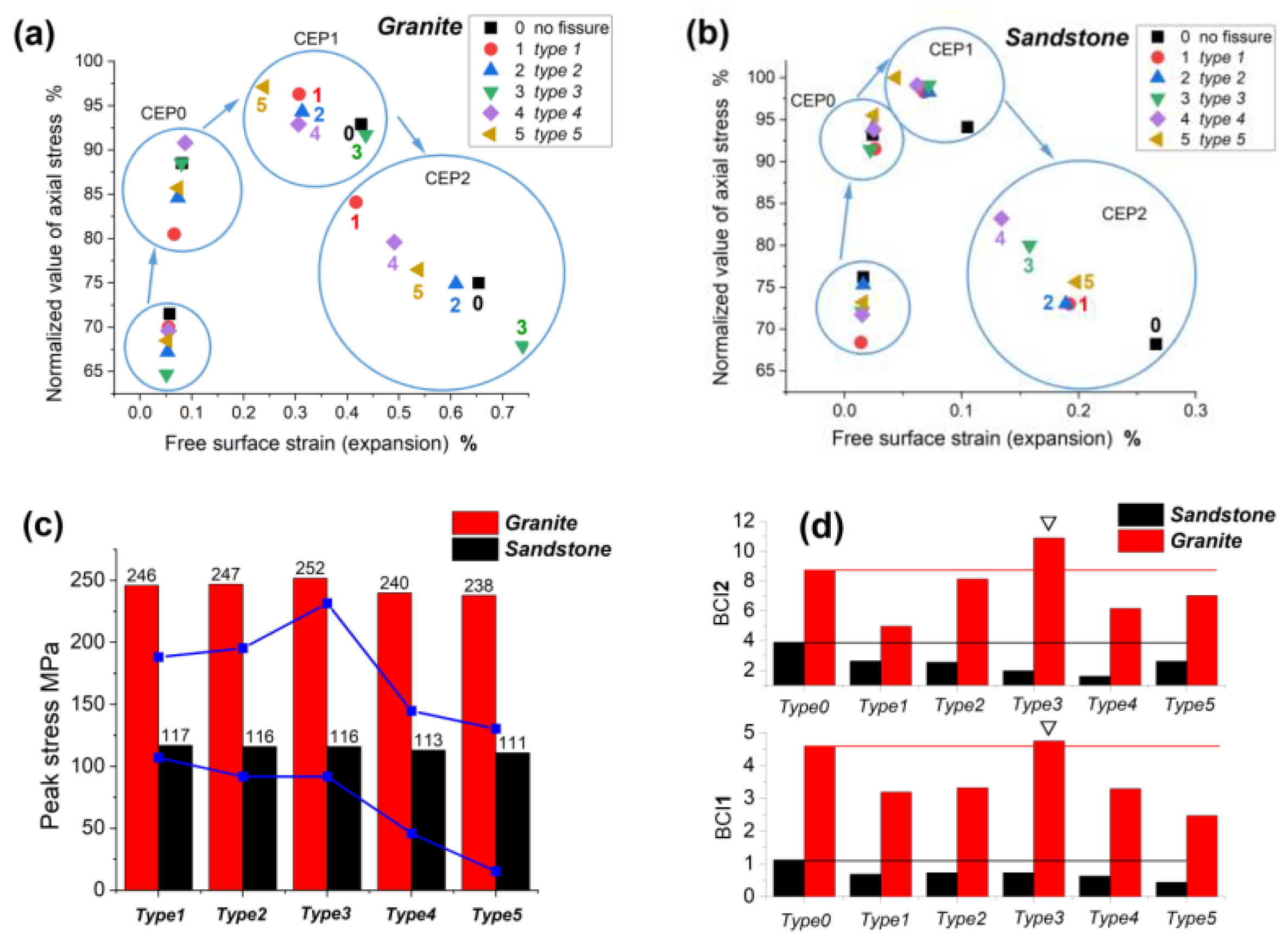
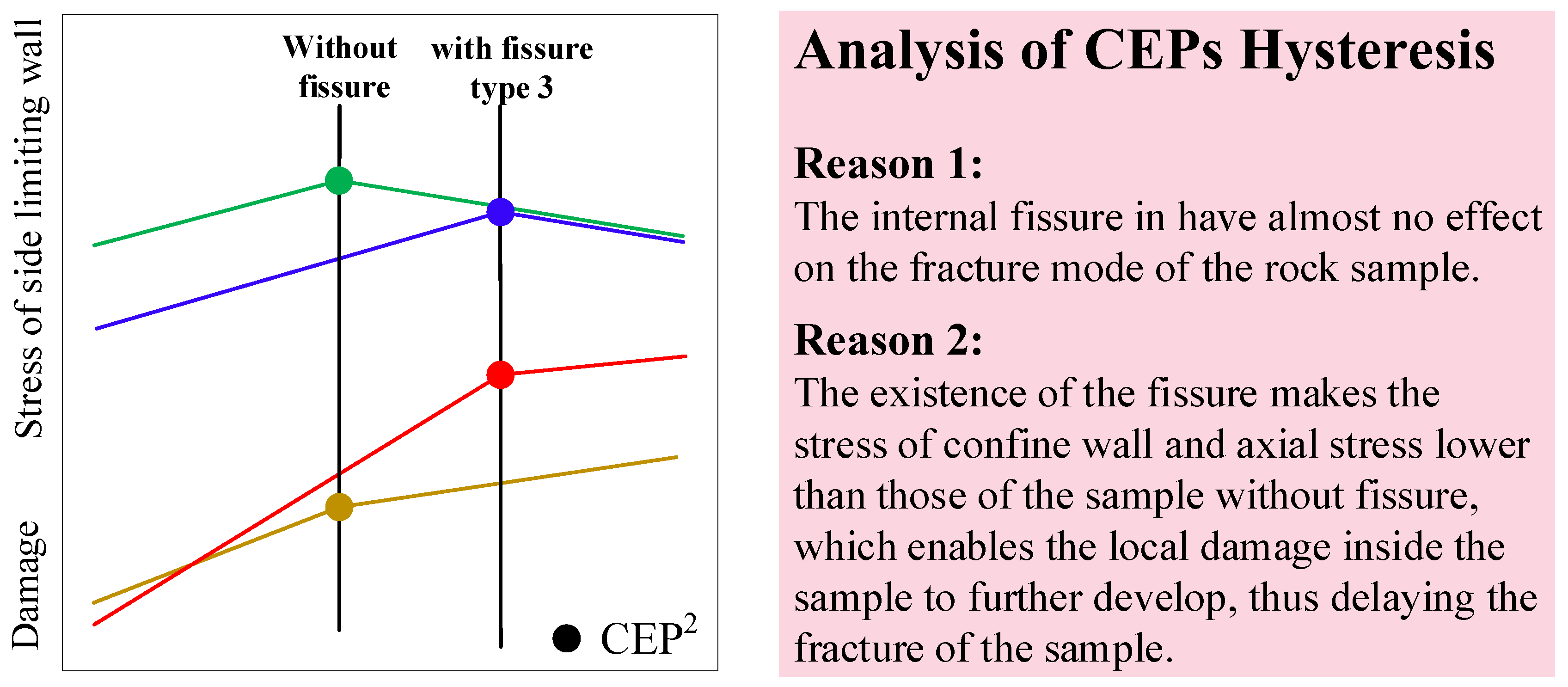
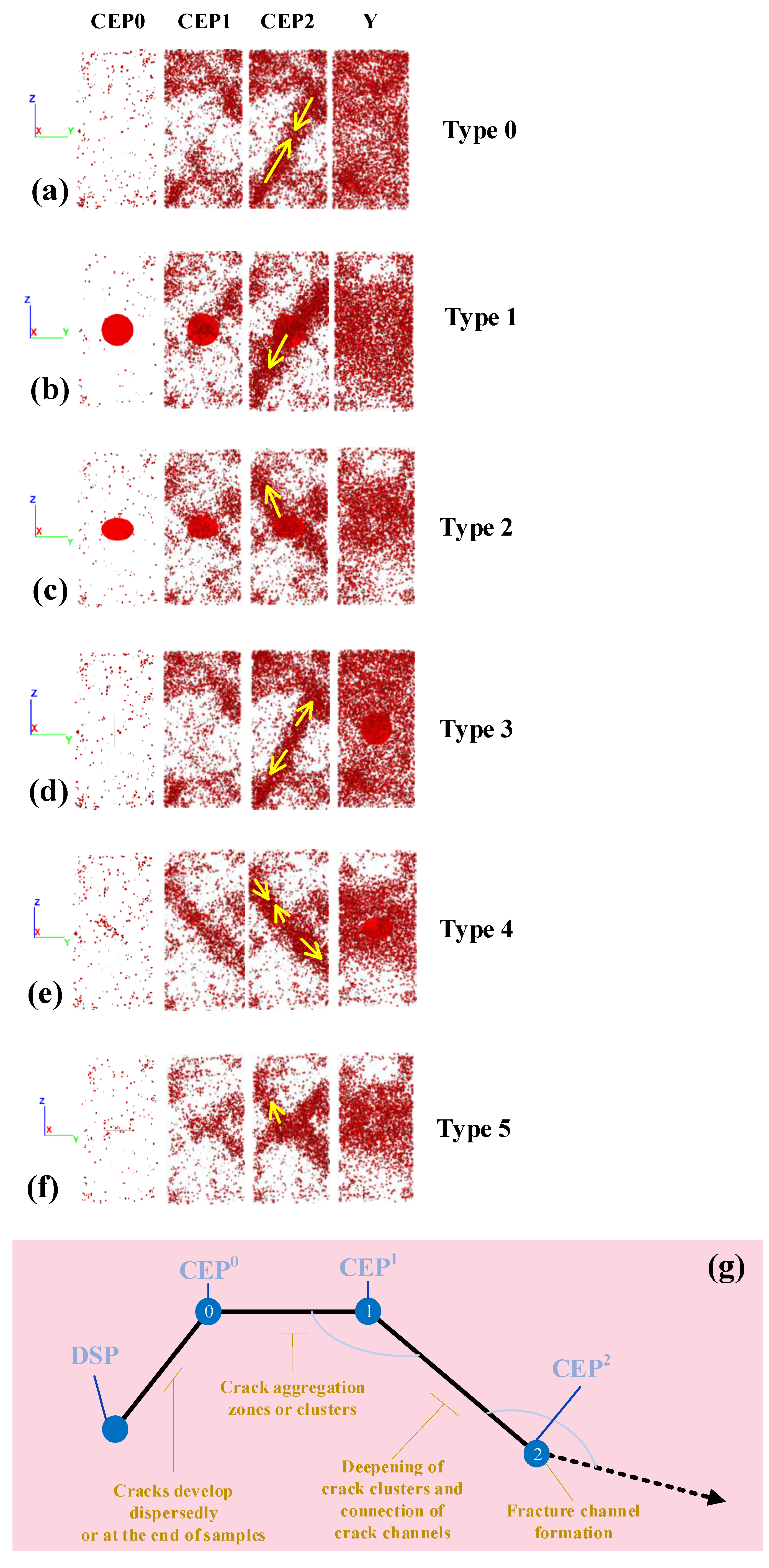
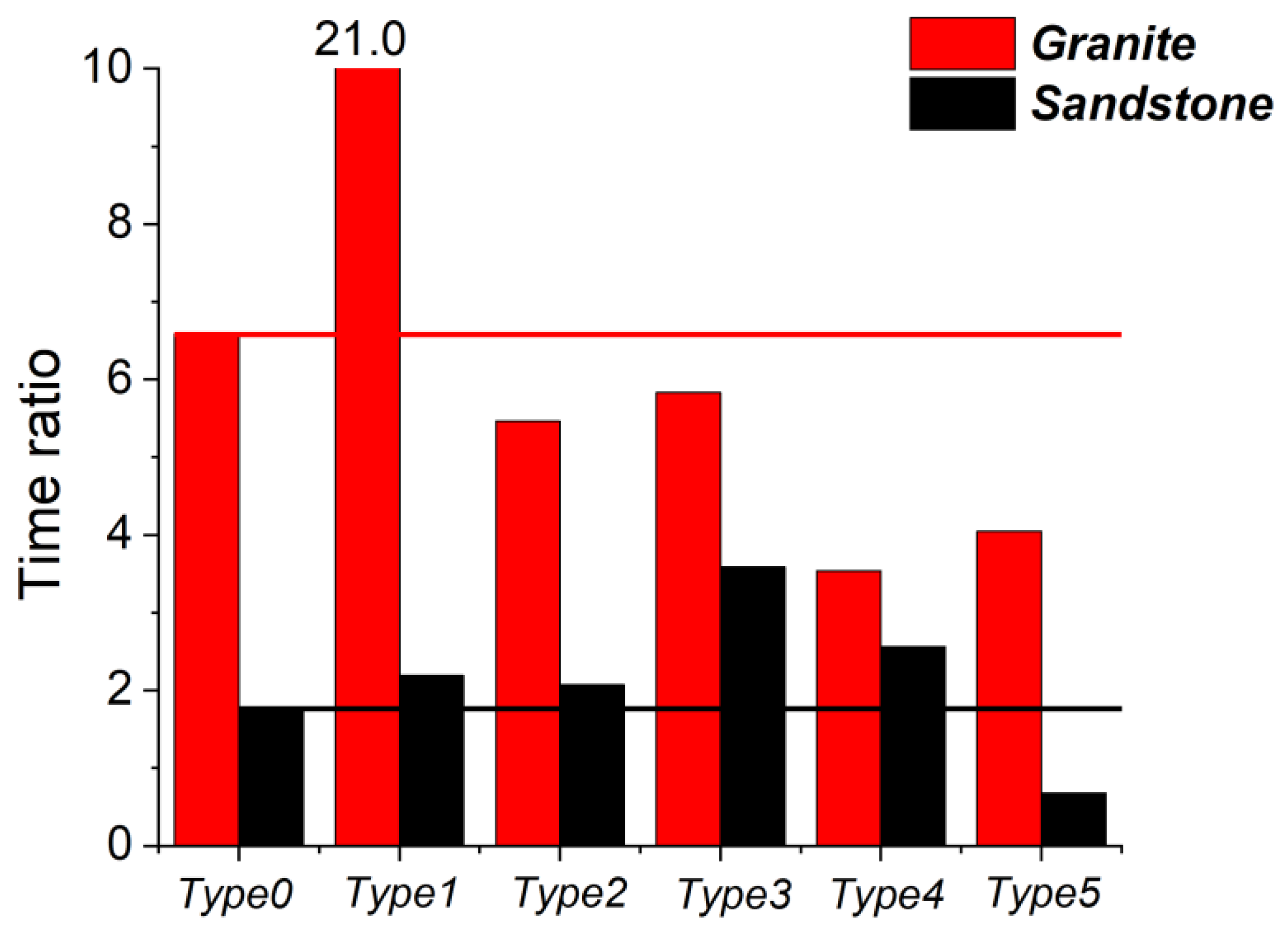
| Lab Test Parameters (III) | PFC Model Parameters (5) | ||||
|---|---|---|---|---|---|
| First Parameter: Effective Modulus | Second Parameter: Normal-to-Shear Stiffness Ratio | Third Parameter: Tension Strength of PBCM | Fourth Parameter: Cohesion of PBCM | Fifth Parameter: Friction Angle of PBCM | |
| I/III Compression strength | Negligible | Weak relation | Positive correlation | Positive correlation | Positive correlation |
| II/III Elasticity modulus | Positive correlation | Power function decreasing relation | Negligible | Negligible | Negligible |
| III/III Poisson ratio | Negligible | Power function increasing relation | Negligible | Negligible | Negligible |
| Granite | Sandstone | |||||
|---|---|---|---|---|---|---|
| Compression Strength/MPa | Elasticity Modulus/GPa | Poisson Ratio | Compression Strength/MPa | Elasticity Modulus/GPa | Poisson Ratio | |
| Lab test results | 214.5 | 48.0 | 0.33 | 113.5 | 60.2 | 0.23 |
| PFC test results | 211.0 | 48.0 | 0.32 | 107.0 | 61.6 | 0.24 |
| Error % | 1.6 | 0.0 | 3.0 | 5.7 | 2.3 | 4.3 |
| Granite | DSP | CEP0 | CEP1 | BCI1 | CEP2 | BCI2 |
|---|---|---|---|---|---|---|
| Type 0 | 0.057 (71.5) | 0.081 (88.5) | 0.427 (92.9) | 4.60 | 0.654 (75.0) | 8.72 |
| Type 1 | 0.055 (70.0) | 0.066 (80.5) | 0.307 (96.3) | 3.19 | 0.417 (84.1) | 4.96 |
| Type 2 | 0.053 (67.2) | 0.073 (84.6) | 0.313 (94.3) | 3.32 | 0.61 (74.9) | 8.14 |
| Type 3 | 0.051 (64.7) | 0.080 (88.5) | 0.436 (91.7) | 4.75 | 0.739 (67.9) | 10.88 |
| Type 4 | 0.055 (69.6) | 0.087 (90.8) | 0.306 (92.9) | 3.29 | 0.491 (79.6) | 6.17 |
| Type 5 | 0.053 (68.5) | 0.074 (85.7) | 0.240 (97.1) | 2.47 | 0.538 (76.5) | 7.03 |
| Sandstone | DSP | CEP0 | CEP1 | BCI1 | CEP2 | BCI2 |
| Type 0 | 0.016 (76.2) | 0.024 (93.2) | 0.105 (94.1) | 1.12 | 0.266 (68.2) | 3.90 |
| Type 1 | 0.014 (68.4) | 0.026 (91.5) | 0.068 (98.3) | 0.69 | 0.193 (73.0) | 2.64 |
| Type 2 | 0.016 (75.3) | 0.024 (94.0) | 0.072 (98.3) | 0.73 | 0.189 (73.7) | 2.56 |
| Type 3 | 0.015 (72.1) | 0.022 (91.4) | 0.072 (99.1) | 0.73 | 0.158 (80.0) | 1.98 |
| Type 4 | 0.015 (71.7) | 0.025 (93.8) | 0.062 (99.1) | 0.63 | 0.134 (83.2) | 1.61 |
| Type 5 | 0.016 (73.2) | 0.025 (95.5) | 0.044 (100.0) | 0.44 | 0.198 (75.6) | 2.62 |
Disclaimer/Publisher’s Note: The statements, opinions and data contained in all publications are solely those of the individual author(s) and contributor(s) and not of MDPI and/or the editor(s). MDPI and/or the editor(s) disclaim responsibility for any injury to people or property resulting from any ideas, methods, instructions or products referred to in the content. |
© 2023 by the authors. Licensee MDPI, Basel, Switzerland. This article is an open access article distributed under the terms and conditions of the Creative Commons Attribution (CC BY) license (https://creativecommons.org/licenses/by/4.0/).
Share and Cite
Wen, J.; Tang, L.; Zhang, S.; Zhan, Q.; Wang, Y. Qualitative and Quantitative Investigations on the Failure Effect of Critical Fissures in Rock Specimens under Plane Strain Compression. Materials 2023, 16, 611. https://doi.org/10.3390/ma16020611
Wen J, Tang L, Zhang S, Zhan Q, Wang Y. Qualitative and Quantitative Investigations on the Failure Effect of Critical Fissures in Rock Specimens under Plane Strain Compression. Materials. 2023; 16(2):611. https://doi.org/10.3390/ma16020611
Chicago/Turabian StyleWen, Jiaqi, Lei Tang, Shenghang Zhang, Qibing Zhan, and Yukun Wang. 2023. "Qualitative and Quantitative Investigations on the Failure Effect of Critical Fissures in Rock Specimens under Plane Strain Compression" Materials 16, no. 2: 611. https://doi.org/10.3390/ma16020611
APA StyleWen, J., Tang, L., Zhang, S., Zhan, Q., & Wang, Y. (2023). Qualitative and Quantitative Investigations on the Failure Effect of Critical Fissures in Rock Specimens under Plane Strain Compression. Materials, 16(2), 611. https://doi.org/10.3390/ma16020611






